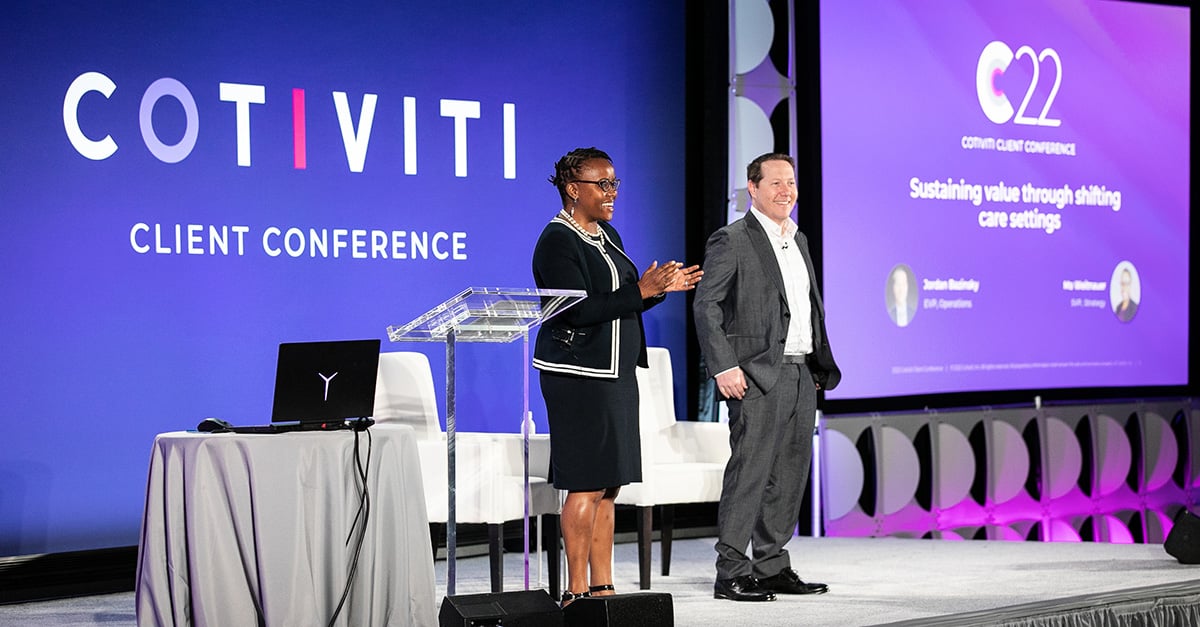Persistent inequities in care delivery and outcomes. Inefficient processes and siloed systems that don’t communicate with one another. Spending the most in the world without achieving the best outcomes. These are just a few of the U.S. healthcare problems that more than 100 Cotiviti clients came together to tackle last week in Charleston, South Carolina at the 2022 Cotiviti Client Conference (CCC22).
While these challenges may seem insurmountable to some, our experience at the conference demonstrated there are many reasons to be optimistic that healthcare stakeholders can make meaningful progress in solving these problems through collaboration, innovation, and rigor. Here are five highlights from CCC22 that Cotiviti will deeply focus on in the coming year to drive better outcomes for our clients and their members.
To tackle healthcare inequities, health plans must do better at member engagement.
One of my favorite speakers of the conference was a leader of a major southeastern payer, the largest in its state. Drawing on his experience as a provider, he reflected on how it’s easy to dismiss patients who miss an appointment as “no-shows.” But when he spent more time in his local community, he realized that healthcare organizations often don’t think about how a patient might not have money to put gas in their car—or quite literally have to choose between refilling a prescription and putting food on the table.
As this speaker put it, health plans are now beginning to realize that they can “do well by doing good.” This goes far beyond sending members a text message to remind them of upcoming appointments. It means paying for them to catch a Lyft for follow-up care. It means partnering with local food banks to reduce food insecurity. It also means bringing care directly to members where they spend time in the community, such as laundromats or libraries, and understanding cultural nuances that go beyond language when reaching out to members.
Plans are also realizing that by increasing technology-driven collaboration between internal departments, such as care management and member services, they can make meaningful progress in closing care gaps. One client in New York noted that since launching a program enabling its member services agents to have care gap information at their fingertips, it has seen a nearly tenfold increase in the amount of conversation it’s having with members about closing their care gaps.
Payers must look to developing technologies and external partnerships to innovate faster.
Let’s face it—implementing large-scale IT projects at most organizations is slow and cumbersome. Health plans often have a backlog of internal initiatives to slog through before they can think about building new capabilities in-house, and security concerns often push organizations to house vast amounts of data on-premises using antiquated systems.
As presented by my colleague Nicole Neumarker, executive vice president of development and innovation, healthcare organizations are increasingly looking to automation and no-code or low-code technologies to greatly improve speed to innovation. This empowers business leaders in the organization who likely don’t have programming expertise themselves to become “citizen developers.” Payers are also turning to increasingly secure cloud-based solutions that enable them to let go of the struggle to maintain a convoluted assortment of on-site data warehouses and installed software. In an environment where numerous critical programs such as payment integrity, risk adjustment, and quality improvement often compete for internal resources, this approach can improve speed-to-value across the enterprise.
Solving payment integrity challenges requires looking beyond prepay vs. postpay.
Traditionally, claims payment integrity has been divided into two simple buckets: prepay and postpay. But this type of siloed thinking has led to competing incentives and suboptimal outcomes. Instead, the optimal approach is to think of payment integrity as what we call a connected claim continuum, where payment integrity challenges are organized by the nature of the problem and how to solve it rather than an arbitrary timeline.
For example, at Cotiviti, we don’t have separate teams for prepay and postpay clinical chart review or coordination of benefits validation. Instead, we are a single team focused on shifting value forward in the claims payment process wherever we can. By aligning processes, delivery mechanisms, and execution within their organizations, payers can simultaneously improve payment integrity savings while reducing provider abrasion.
Beyond healthcare fraud, there is more opportunity to prevent the “in-between” challenges of waste and abuse.
The “F” part of FWA generally gets the most attention, and it’s not hard to see why. Bad actors will unfortunately always be a part of our healthcare system, and the painstaking work done by special investigative units (SIUs) in collaboration with law enforcement will remain vital. But while it might not get very many headlines, more can be done when it comes to preventing waste and abuse from providers.
As noted by one of our clients, an SIU director, provider education such as correct coding initiatives can go a long way toward preventing future inappropriate claims. After all, providers want their claims to be paid promptly. During their daily auditing and data mining processes, payers can begin to detect patterns and see where their provider network would benefit from coding education with an eye toward correction and collaboration, not punishment.
Health plans must get ahead of shifting sites of care.
By now, we all know that the explosive growth in telehealth driven by the COVID-19 pandemic will be a lasting part of our healthcare system. But equally important is the growth of healthcare delivery in other settings outside of inpatient care, including at home, at ambulatory surgical centers, and in retail settings, where many forms of primary care can be delivered in an environment where consumers are used to shopping for groceries or other household items.
Ultimately, delivering care in these lower-cost settings will be beneficial for our entire healthcare system. However, payers must be vigilant in ensuring that the quality of healthcare delivery in these settings increases, not decreases. These alternative sites of care should not be seen as simply a way to contain costs, but rather an opportunity for payers to reach their members right where they are.
Despite the many challenges that remain in the U.S. healthcare system, CCC22 demonstrated that when healthcare organizations collaborate, tremendous things can be accomplished. We have already integrated many of these learnings from CCC22 into our daily operations and look forward to partnering with our clients to make a meaningful difference for all stakeholders in our healthcare system.
With the average Medicare Advantage (MA) beneficiary having 39 plans to choose from in 2022, the competition is getting even tougher—and plans that haven’t taken advantage of every opportunity to drive risk adjustment excellence will fall behind.
Read our new eBook for key strategies to improve your results, including:
- “Next best action” analytics to support comprehensive gap closure
- Increased digital capture, interoperability, and SDoH collection
- Mitigating compliance audit exposure






